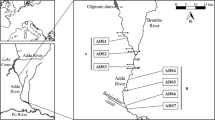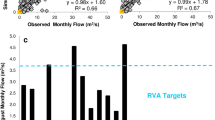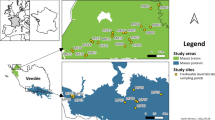Abstract
The response of aquatic organisms to flow regulation at hydro facilities has become a key issue for the development of sustainable management practices intending to reduce the impact in regulated rivers. In previous studies, unrestricted ramping rates have been found to have a negative effect on invertebrate communities and shortened the length of the food web. The decrease in the length of the food web was inferred from a significant decrease in the difference between macroinvertebrates and fish δ13N signatures, equivalent to the loss of the one trophic level. A before-after-control-impact (BACI) design was applied to determine the possible effects of ramping rate restrictions on the diet of small-bodied fishes in a boreal river in northern Ontario. Stomach contents were identified to the taxonomic level of order. Using these data, abundance, diversity and taxa composition were calculated to yield an understanding of the alterations that occurred in the food web, and how fish species diets may have changed to compensate for the shift in the invertebrate trophic level. It was found that unrestricted ramping rates were associated with an increase in invertebrate abundance within the stomach contents. There was no effect from the change to unlimited ramping for both stomach content EPT abundance and species diversity, as both rivers followed a similar trend over time. After unrestricted ramping rates, a greater frequency of baseline taxa and a lower frequency of predatory macroinvertebrates were found within the altered river stomach contents compared to what was expected. This demonstrates that the diets of small-bodied fishes have changed to compensate for the alterations to the food web due to unrestricted ramping rates, and implies that ramping rates should be taken into consideration in the regulation of operating regimes on altered rivers.






Similar content being viewed by others
References
Acers International (1994) Steephill Falls flow studies. Unpublished, Prepared for Great Lakes Power Limited by Acres International, Niagara Falls, Ontario
Bednarek A, Hart D (2005) Modifying dam operations to restore rivers: ecological responses to Tennessee River dam mitigation. Ecol Appl 15:977–1008
Bowen S, Lutz E, Ahlgren M (1995) Dietary protein and energy as determinants of food quality: trophic strategies compared. Ecol Soc Am 76:899–907
Bunn S, Arthington A (2002) Basic principles and ecological consequences of altered flow regimes for aquatic biodiversity. Environ Manag 30:492–507
Canadian Electricity Association (CEA) (2009) Key Canadian electricity statistics. Unpublished, http://www.electricity.ca. Accessed March 2010
Clarke K, Pratt T, Randall R, Scruton D, Smokorowski K (2008) Validation of the flow management pathway: effect of flow alteration on fish habitat and fishes downstream from hydropower dam. Can Tech Rep Fish Aquat Sci 2784, vi +111p
Dytham C (2003) Choosing and using statistics: a biologist’s guide, 3rd edn. Blackwell Publishing, Oxford, pp 32–40, 72–144
ESSA Technologies LTD. (1999) Meeting on Steephill Falls case study of the effects of increased ramping rates. Department of Fisheries and Oceans. Unpublished, Great Lakes Laboratory for Fisheries and Aquatic Sciences. Sault. Ste. Marie, Ontario
Fry B, Sherr E (1984) δ13C measurements as indicators of carbon flow in marine and freshwater ecosystems. Ecol Stud 27:15–47
Grafen A, Hails R (2009) Modern statistics for the life sciences. Oxford University Press, New York
Grossman G, Rincon P, Farr M, Ratajczak R (2002) A new optimal foraging model predicts habitat use by drift-feeding stream minnows. Ecol Freshw Fish 11:2–10
Harrel S, Dibble E (2001) Foraging efficiency of juvenile blugill, lepomis macrochirus, among different vegetated habitats. Environ Biol Fish 62:441–453
Hudson P, Nichols S (1986) Benthic community of the Savannah River below a peaking hydropower station. J N C Acad Sci 102:107–121
Hurlebert H (1971) The nonconcept of species diversity: a critique and alternative parameters. Ecology 52:577–585
Jackson D, Peres-Neto P, Olden J (2001) What controls who is where in freshwater fish communities the roles of biotic, abiotic, and spatial factors. Can J Fish Aquat Sci 58:157–170. doi:10.1139/cjfas-58-1-157
Loomis E, Sjoeberg J, Wong H (2011) Abundance and stomach content analysis of threadfin shad in Lake Mead, Nevada: do invasive quagga mussels affect this prey species? Aquat Invasions 6:157–168
Mackie G (2004) Applied aquatic ecosystem concepts, 2nd edn. Kendall/Hunt Publishing Company, Dubuque, pp 105–142, 250, 319, 392–395, 703
Maroneze D, Tupinambas T, Alves C, Vieira F, Pompeu P, Callisto M (2011) Fish as ecological tools to complement biodiversity inventories of benthic macroinvertebrates. Hydrobiologia 673:29–40
Marty J, Smokorowski K, Power M (2009) The influence of fluctuating ramping rates on the food web of boreal rivers. River Res Appl 25:962–974
Masese FO, Muchiri M, Raburu PO (2009) Macroinvertebrate assemlages as biological indicators of water quality in the Moiben River, Kenya. Afr J Aquat Sci 34:15–26
Maxwell T, Jennings S (2006) Predicting abundance-body size relationship in functional and taxonomic subsets of food web. Oecologia 150:282–290
McCune G, Grace J (2002) Analysis of ecological communities. MjM software Design, Gleneden Beach
Murchie K, Smokorowski K (2004) Relative activity of brook trout and walleyes in response to flow in regulated river. N Am J Fish Manag 24:1050–1057
Patterson R, Smokorowski K (2010) Assessing the benefit of flow constraints on the drifting invertebrate community of a regulated river. Rivers Res Appl. doi:10.1002/rra.1342
Power M, Guiguer K, Bethesda D (2003) Effects of temperature on isotope enrichment in daphnia magna: implications for aquatic food-web studies. Rapid Commun Mass Spectrom 17:1619–1625
Rader R, Belish T (1999) Influence of mild to severe flow alterations on invertebrates in three mountain streams. Regul Rivers Res Manag 15:353–363
Richter BD, Matthews R, Harrison DL, Wingington R (2003) Ecologically sustainable water management: managing river flows for ecological integrity. Ecol Appl 13:206–224
Sabater S (2008) Alterations of the global water cycle and their effects on river structure function and services. Freshw Rev. doi:10.1608/FRJ-1.1.5
Smokorowski KE (2010) Effects of experimental ramping rate of invertebrate community of a regulated river. Proceedings of the Colorado River Basin Science and Resource Management Symposium, pp 149–156
Smokorowski KE, Metcalfe RA, Jones N, Marty J, Niu SL, Pyrce RS (2009) Studying ramping rate restrictions. Hydro Review, pp 68–88
Smokorowski KE, Metcalfe RA, Finucan SD, Jones N, Marty J, Power M, Pyrce RS, Steele R (2010) Ecosystem level assessment of environmentally-based flow restrictions for maintaining ecosystem integrity: a comparison of a modified peaking vs. unaltered river. Ecohydrology 4:791–806. doi:10.1002/eco.167
Webb S, Hedges R, Simpson S (1998) Diet quality influences the δ15N and δ13C locusts and their biochemical components. J Exp Biol 201:2903–2911
Wright J, Winder J, Gunn R, Blackburn J, Symes K, Clarke R (2000) Minor local effects of a River Thames power station on the macroinvertebrate fauna. Regul Rivers Res Manag 16:159–178
Acknowledgments
This study was funded by Fisheries and Oceans Canada and Brookfield Renewable Power Ltd and approved by the Canadian Council of Animal Care. Samples were provided by Fisheries and Oceans Canada and collected by Jérôme Marty of the Department of Biology at the University of Waterloo, and by Marla Thibodeau and Lisa Voigt of Fisheries and Oceans Canada. Laboratory assistance was provided by Marla Thibodeau of Fisheries and Oceans Canada. Lee Gutowsky, Jason Thiem and Emily Brady provided valuable critical commentary of the paper and statistical analysis.
Author information
Authors and Affiliations
Corresponding author
Rights and permissions
About this article
Cite this article
Tuor, K.M.F., Smokorowski, K.E. & Cooke, S.J. The influence of fluctuating ramping rates on the diets of small-bodied fish species of boreal rivers. Environ Biol Fish 98, 345–355 (2015). https://doi.org/10.1007/s10641-014-0264-5
Received:
Accepted:
Published:
Issue Date:
DOI: https://doi.org/10.1007/s10641-014-0264-5




